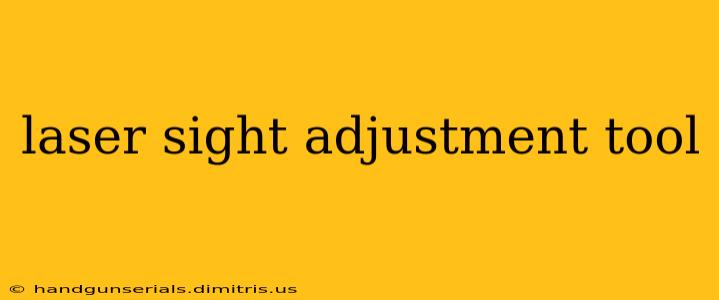Finding the perfect zero for your laser sight is crucial for accuracy and effectiveness, whether you're a seasoned marksman or a first-time user. This guide will delve into the world of laser sight adjustment tools, explaining their purpose, different types available, and how to use them effectively to achieve optimal performance.
Understanding Laser Sight Adjustment
Before diving into the tools, it's essential to understand the principles of laser sight adjustment. Most laser sights utilize a system of adjustable screws—typically two (windage and elevation)—that allow you to fine-tune the point of impact. Windage adjusts the laser's horizontal position, while elevation adjusts its vertical position. These adjustments are usually made in small increments, requiring precision tools for accurate calibration.
Types of Laser Sight Adjustment Tools
Several tools can facilitate this precise adjustment, each with its own advantages and disadvantages:
1. Allen Wrenches (Hex Keys):
- Description: These are the most common tools for adjusting laser sights. They come in various sizes, so it's crucial to identify the correct size for your specific laser sight model.
- Advantages: Readily available, inexpensive, and simple to use.
- Disadvantages: Can be challenging to use precisely for minute adjustments, especially in tight spaces. A slip can damage the screw or the sight itself.
2. Small Screwdrivers:
- Description: Similar to Allen wrenches, small screwdrivers, particularly those with precision tips, can be used for laser sight adjustments.
- Advantages: Can offer better control and leverage than some Allen wrenches, depending on the screwdriver's design.
- Disadvantages: Like Allen wrenches, the risk of slippage and damage remains, requiring careful and controlled adjustments.
3. Specialized Laser Sight Adjustment Tools:
- Description: Some manufacturers offer specialized tools specifically designed for adjusting their laser sights. These are usually more ergonomic and precise than standard Allen wrenches or screwdrivers.
- Advantages: Often provide superior control and prevent damage due to their precise fit and design.
- Disadvantages: May be more expensive and only compatible with specific laser sight models.
Choosing the Right Tool
The best tool for you depends on your laser sight and your comfort level. If your laser sight uses standard Allen screws, a high-quality set of Allen wrenches will usually suffice. However, for improved precision or if your laser sight has unusual screw types, investing in a specialized tool may be beneficial. Always prioritize tools made from durable materials to minimize the risk of tool slippage and potential damage to your equipment.
Tips for Accurate Adjustment
Regardless of the tool you choose, follow these tips for accurate and safe adjustments:
- Use a stable platform: Secure your firearm in a vise or on a sturdy surface to minimize movement during adjustment.
- Start with small adjustments: Make small, incremental adjustments to avoid overcorrecting.
- Test frequently: After each adjustment, test the laser's point of impact at your chosen distance.
- Patience is key: Precise adjustment takes time and patience. Don't rush the process.
- Consult your manual: Your laser sight's manual should contain specific instructions for adjustment.
Conclusion
Properly adjusting your laser sight significantly enhances accuracy and performance. Selecting the appropriate tool and following a methodical adjustment process ensures your laser remains consistently reliable in any situation. Remember to always prioritize safety and handle your firearm responsibly. By understanding the principles of adjustment and utilizing the right tools, you can confidently achieve the optimal zero for your laser sight.

